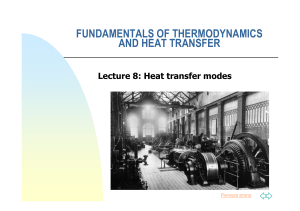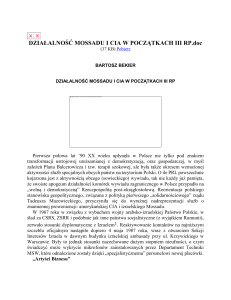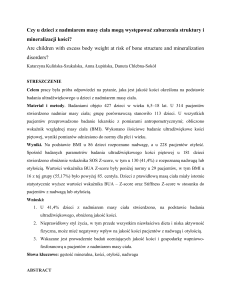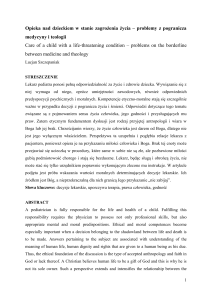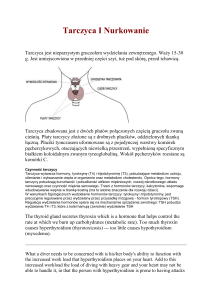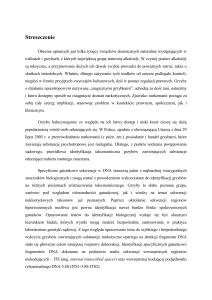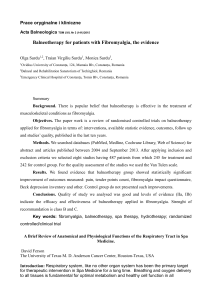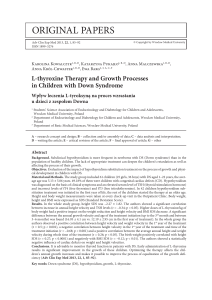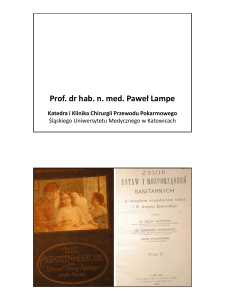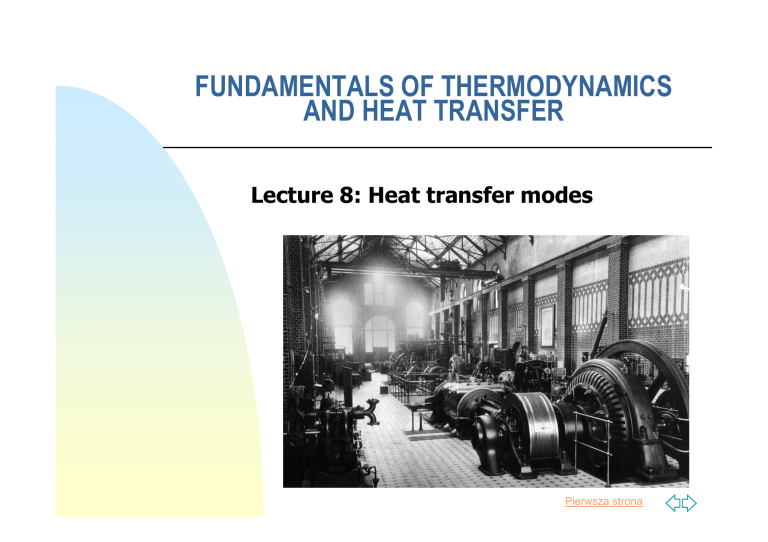
FUNDAMENTALS OF THERMODYNAMICS
AND HEAT TRANSFER
Lecture 8: Heat transfer modes
Pierwsza strona
What is heat transfer?
Science about energy, its
conversion and transfer
Considered will be energy
conversion to its useful
forms.
Power engineering
Chemical engineering
Electronics
Space technology
Wymiana Ciepła
Heat transfer processes
Uses the elements of several disciplines:
Classical thermodynamics
Thermodynamics of irreversible processes
Statistical thermodynamics
Fluid mechanics
Mathematics
Physics
Technology development – design for operation at extreme
parameters (space technology, microelectronics)
Energy conversion – degradation of natural environment
Wymiana Ciepła
First Law of Thermodynamics
Conservation of energy – energy cannot be formed in the isolated system, can only
change its form.
Second Law of Thermodynamics
Energy has quality and quantitiy. The quality can only be reduced in closed
systems.
Wymiana Ciepła
Flow of thermal energy is always from a body
having a higher temperature to a body with lower
temperature.
Wymiana Ciepła
Fundamentals
Ciepło – sposób przepływu energii między
ciałami, wynika z I ZT
Nie może samorzutnie przechodzić od ciała o
temperaturze niższej do ciała o wyższej temp.
Wymiana ciepła – związki między ilością
przepływającego ciepła, a różnicą temperatur i
czasem trwania zjawiska (złożony problem)
Wymiana Ciepła
Wymienniki ciepła – urządzenia, w których zachodzi
wymiana ciepła (rekuperatory, regeneratory, wymienniki
mieszankowe)
Fundamentals
Rate of heat
dQ
&
Q=
dτ
Heat flux density
d 2Q
q=
dA dτ
Heat transfer between the wall and a fluid –
convection
Wymiana Ciepła
Heat transfer between two fluids separated by
the wall – complex heat transfer
Wymiana Ciepła
Heat energy transfer mechanisms
o Conduction
o Convection
o Radiation
Conduction
This is the mechanism by which heat is transferred from
one part of an object to another part through molecular
collisions. If one part of an object is hotter than its
neighboring part, the molecules in the hotter part have
more energy and vibrate more vigorously than their
neighbors. When they collide with their neighboring
molecules which vibrate less vigorously, energy is
transferred to the latter and the temperature of the colder
part increases.
Free electrons (electrons that has become detached from
their parent molecules) also play a important part in the
thermal conduction as they provide an effective
mechanism for carrying heat energy from one part of an
object to another part. Metals are good electrical
conductors because they have a lot of free electrons.
Hence they are also good conductors of heat.
Thermal conductivity
The rate of heat transfer through thermal conduction is
proportional to the cross-sectional area and the
temperature difference, and inversely proportional to the
thickness:
∆T
Q
∝A
∆x
∆t
For a slab of infinitestimal thickness dx and temperature
difference dT , the thermal conduction equation can be
written as:
Q
dT
= −kA
∆t
dx
The proportional constant k is called the thermal
conductivity. The negative sign is introduced to adopt
the convention that the direction of heat flow is opposite
to the direction of increasing temperature.
Conduction of heat
Conduction: collissions and difussion of particles
Wymiana Ciepła
Thermal conductivities of some substances
Substance
Metals (at 25oC)
Silver
Copper
Aluminum
Iron
k (W/mK)
427
390
238
79.5
Nonmetals (approximate values)
Concrete
Glass
Water
Rubber
Wood
Asbestos
0.8
0.8
0.6
0.2
0.08
0.08
Air (at 20oC)
0.0234
Wymiana Ciepła
Wymiana Ciepła
Wymiana Ciepła
Steady state thermal conduction
In steady state, the rate of heat flow through an insulated
uniform rod can be determined using the equation:
Q
T −T
= kA
∆t
L
2
1
where T2 is the temperature at the hotter end of the rod, T1
the temperature at the colder end of the rod, A the crosssectional area of the rod, and L its length.
Heat transfer through compound slabs
Often compound slabs consisting several layers of
different materials are used for insulation. The rate of heat
transfer through such a slab can be calculated from the
thermal conductivities of the materials that make up of the
slab.
Consider a compound slab consisting
of two materials of thicknesses L1, L2
and thermal conductivities k1, k2
respectively. The temperatures of the
outer surfaces are T1 and T2, where T2
> T1. Let the temperature at the
interface be T. Since the heat transfer
rates through the two layers must be
the same, we have
k1A(T – T1)
L1
=
k2A(T2 – T)
L2
Solving the equation for T, we have
T=
k1L2T1 + k2L1T2
k1L2 + k2 L1
Substituting this expression for T in the heat transfer
rate equation for either layer, we obtain
Q
∆t
=
A ( T2 – T1 )
L1 / k1 + L2 / k2
The rate of heat transfer through a compound slab
consisting of n materials can be generalized from the 2layer equation:
Q
∆t
A ( T2 – T1 )
=
n
Σ Li / ki
i=1
L/k for a particular substance is often referred to as the
R value of the material, and the above equation can be
written in terms of the R values:
Q
∆t
=
A ( T2 – T1 )
n
Σ Ri
i=1
R values of some common building materials
Material
Hardwood siding (1”)
Brick (4”)
Fiberglass board (1”)
Flat glass (0.125”)
Air space (3.5”)
Drywall (0.5”)
Stagnant air layer*
R value (mK/W)
0.25
1.00
1.10
0.30
0.25
0.10
0.04
*At any vertical surface open to the air, a very thin stagnant
layer of air adheres to the surface and the R value of this
stagnant air layer on an outside wall depends on wind
speed. When determining the R value of a wall, one must
consider the stagnant air layers on both sides of the wall.
Example: What is the R value of a wall consisting
of a 4” brick layer, a 2” fiberglass board and a 0.5”
dry wall?
R1 (outside stagnant air layer) 0.04 mK/W
R2 (brick)
1.00
R3 (fiberglass board)
2.20
R4 (dry wall)
0.12
R5 (inside stagnant air layer)
0.04
ΣRi
3.38 mK/W
Radial heat flow
Consider a steam pipe of radius a, surrounded by a layer of insulating
material of outer radius b, length L and thermal conductivity k. If the
temperature of the steam pipe is T2 and that of the air outside the
insulating material is T1 (T1 < T2), What is the rate of energy transfer
through the insulating material and what is the temperature at r (a < r
< b) when a steady state has been reached?
2a
Law of thermal conduction:
Q
dT
= − kA
dr
∆t
Q
∆t
Insulating
material
k
is constant at steady state
Representing
Q
∆t
by H, the law can be written as:
H = − k (2πrL)
T2
Steam pipe
dT
dr
T1
2b
L
1
2πkL
dT
From the above equation: ∫ dr = − ∫
r
H
ln r = −
2πkL
T +c
H
⇒
(equ. 1)
where c is an integration constant.
At r = a, T = T2
2πkL
ln a = −
T2 + c
H
(equ. 2)
At r = b, T = T1
2πkL
ln b = −
T1 + c
H
(equ. 3)
Solving equ. 2 and equ 3 for H and c:
2πkL(T 2 − T 1)
H=
ln(b / a )
c=
(This is the rate of energy transfer)
T 2 ln b − T 1 ln a
T 2 − T1
Substituting the expressions for H and c in equ 1, we have
T 2 ln(b / r ) + T 1 ln(r / a )
T=
ln(b / a )
Convection
This is the mechanism by which heat is transferred by actual
motion of material.
Natural convection:
The material flows due to differences in density (caused by
thermal expansion).
Examples: Air flow at a beach.
Water mixing in a lake when its surface is cooled.
Forced convection:
The material if forced to move by a blower of pump.
Examples: Hot-water heating system.
Flow of blood in the body.
Heat convection
Energy transfer by means opf
convection takes place by
movement of hot particles
upwards and falling of colder
ones.
Wymiana Ciepła
Wymiana Ciepła
Heat transfer by convection
There is no simple equation for calculating the
amount of heat transferred by convection. The heat
lost or gained by a surface at one temperature in
contact with a fluid at another temperature depends
on many factors, such as the shape and orientation
of the surface, the mechanical and thermal
properties of the fluid and the nature of fluid flow
(laminar or turbulent).
For practical calculations, the following equation is often
used:
Q
= h A ∆T
∆t
Q
where,
∆t
= rate of energy transfer or heat current
A = surface area
∆T
= temperature difference between the surface
and the main body of the fluid
h
= convection coefficient
Convection coefficient
The convection coefficient defined in the above equation is
temperature dependent and needs to be determined
experimentally.
A situation of practical important is that of natural
convection from a wall or a pipe that is at constant
temperature and is surrounded by air at atmospheric
pressure whose temperature is less than that of the wall or
pipe by ∆T. The convection coefficients applicable in this
situations are shown below:
h, (W·m-2 ·K-1)
Horizontal plate, facing upward
0.0595x10-4(∆T)1/4
Horizontal plate, facing downward 0.0314x10-4(∆T)1/4
Vertical plate
0.0424x10-4(∆T)1/4
Horizontal or vertical pipe (dia. D) 1.00x10-4(∆T/D)1/4
Złożona wymiana ciepła
Przenikanie jako przykład złożonej wymiany ciepła w przypadku płaskiej ścianki można przedstawić
następująco:
δ
Tf1
konwekcja, α1
Tf2
konwekcja, α2
przewodzenie, λ
Q& =
Wymiana Ciepła
Tf1 − Tf 2
R
R=
1
1
δ
+
+
α 1 A λA α 2 A
Radiation
This is the mechanism by which heat is transferred by
continual emission of energy from the surface of a body.
This energy is called radiant energy and is in the form of
electromagnetic waves. These waves travel with the speed
of light and are transmitted through vacuum as well as
through. When they fall on a body that is not transparent to
them, such as the surface of one’s hand or the walls of a
room, they are absorbed, resulting in a transfer of heat to the
absorbing material.
The radiant energy emitted by a surface depends on the
nature of the surface and on its temperature. At any
temperature, the radiant energy emitted is a mixture of waves
of different wavelengths, and the mixture is a function of
temperature.
Wymiana Ciepła
Wymiana Ciepła
Wymiana Ciepła
Wymiana Ciepła
Radiant energy from the Sun
•
The amount of radiant energy reaching the top of the
Earth’s atmosphere from the Sun is approximately 1340 J
per second.
•
Some of this energy is reflected into the space and some
absorbed by the atmosphere. The amount of the Sun’s
radiant energy that reaches the surface of the Earth is
hundreds of times of all the energy needed on this planet.
•
The Sun’s radiant energy is primary visible and infrared
light accompanied by a significant amount of ultraviolet
radiation.
•
The Sun influences the Earth’s average temperature,
ocean currents, agriculture, rain patterns, etc.
Stefan’s law
The rate at which an object radiates energy is proportional to
the fourth power of its absolute temperature. This is know as
Stefan’s law:
Q
∆t
= σ A e T4
where σ = 5.6696x10-8 W·m-2·K-4 (Stefan-Boltzmann constant)
A = surface area of the object in m2
e = emissivity of the object
T = the surface temperature of the object in kelvins.
This relation was deduced by Josef Stefan (1835-1893) on the basis of
experimental measurements made by John Tyndall (1820-1893) and was
later derived from theoretical considerations by Ludwig Boltzmann
(1844-1906). Hence, it is also called Stefen-Boltzmann law.
Emissivity
•
It is the fraction of the incoming radiation the surface
absorbs.
•
It has a value if the range 0 – 1.
•
It depends on the properties of the surface of the object,
generally larger for dark and rough surfaces than for light
and smooth ones.
•
A good radiant energy emitter has a large emissivity,
hence it is also a good absorber and a poor reflector.
•
A poor radiant energy emitter is also a poor absorber and
a good reflector.
•
An “ideal” absorber (e = 1) reflects no radiant energy,
and hence would appear black in color. Such an ideal
absorber is called blackbody.
As an object radiates electromagnetic energy, it also
absorbs electromagnetic radiation, otherwise its
temperature would reduce to absolute zero. The amount
of electromagnetic energy absorbed by an object depends
on the temperature of its surroundings. If an object at a
temperature T and its surroundings are at temperature To,
then the rate of net energy gained (or lost) by the object
due to emission and absorption of electromagnetic
radiation is:
Q
∆t
= σ A e (T 4 - To4)
Hence, if T > To , The object radiates more energy than it
absorbs, and its temperature decreases until equilibrium
with its surroundings is reached.
Example: A metal block of dimensions 10 cm x 10 cm x 0.2
cm is heated by an electric heater to 800 oC in vacuum. If
the emissivity of the metal block is 0.9, how much electric
power input to the heater would be required to maintain the
metal block at this temperature?
To maintain the metal block at a fixed temperature, the electric power
input to the heater must be equal to the rate of energy loss by radiation.
Rate of radiant energy loss:
Q
∆t
= σ A e T 4,
where σ = 5.6696x10-8 W·m-2·K-4
A = 2 x (0.1x0.1 + 0.1x0.002 + 0.1x0.002) = 0.0208
e = 0.9
T = 800 +273.15 = 1073 K
Q
∆t
= 5.6696 x 0.0208 x 0.9 x (1073)4 x 10-8
= 1407 W
The Dewar flask
The Dewar flask (invented by James Dewar) is a container
designed for storage of cold or hot liquids for long period
of time. It is a Pyrex glass vessel and has a design as shown
in the diagram below.
•
•
It has two walls with evacuated
space in between to minimize
energy transfer by conduction
and convection.
The surfaces of the wall are
coated with silver (a very good
reflector with low emissivity)
to minimize energy transfer by
radiation.
Przewodzenie w ciałach o małym oporze
Przewodzenie w ciałach o małym oporze cieplnym (Lumped Capacity Method) jest potężnym narzędziem w obliczeniach niestacjonarnej
wymiany ciepła.
Przyjmijmy, że ciało ma objętość V, powierzchnię A, gęstość właściwą ρ, oraz ciepło właściwe c. Jego temperatura T, jest jednakowa w całej
objętości, i zmienia się na skutek wymiany ciepła z otaczającym je płynem o stałej w czasie temperaturze T∞.
powierzchnia A
objętość, V
ρ, c, T(t)
dU
= − qA
dt
Wymiana Ciepła
olej w temp.
U = Vρc(T − T0 )
T∞
q = α (T − T∞ )
Przewodzenie w ciałach o małym oporze
Podstawiając powyższe wyrażenia do równania bilansu energii:
Vρ c
Warunki brzegowe:
dT
= − Aα (T − T∞ )
dt
dla t = 0
T = T0
dT
αA
=−
dt
T − T∞
ρ cV
Po przekształceniach:
τ
αA
dT
∫T T − T∞ = − ρcV ∫0 dt
0
T
Rozwiązanie równania ma postać:
αA
T − T∞
αA
=−
τ
ρcV
T0 − T∞
τ
−
τ
−
T − T∞
= e ρcV = e τ 0
T0 − T∞
Wymiana Ciepła
ln
Cieplna stała czasowa:
τ0 =
ρ cV
αA
Zdefiniujmy bezwymiarową temperaturę oraz czas:
Przewodzenie w ciałach o małym oporze
T* =
T − T∞
T0 − T∞
τ* =
T* =
T −T∞
T0 −T∞
τ α Aτ
=
τ 0 ρcV
Umożliwia to nam analizę
przypadków gdzie występuje
gwałtowna zmiana
temperatury
τ αAτ
τ* = =
τ0 ρcV
Aby teoria przewodzenia ciepła miała zastosowanie musi być spełniony warunek, że opór przewodzenia w ciele stałym musi być dużo
mniejszy od oporu przejmowania ciepła na zewnątrz
Wymiana Ciepła
Przewodzenie w ciałach o małym oporze
Ciała stałe
opór przewodzenia wewnąewn L / (λA) αl
≈
=
opór konwekcji na zewnąewn 1 / (αA) λ
Mieszalnik
opór przewodzenia wewnąewn 1 / (αA) U
≈
=
opór konwekcji na zewnąewn 1 / (UA) α
Bi =
Zdefiniujmy bezwymiarową liczbę Biota:
αl
λ
Wymiar charakterystyczny, l, jest wyrażony stosunkiem V/A
Teorię można stosować w przypadku, gdy Bi<0.1 dla płaskich płyt, walców, kul.
Wymiary charakterystyczne dla różnych przypadków:
1.
Płyta o grubości l:
L=l/2
2.
Walec o promieniu R:
L=R/2
3.
Kula o promieniu R
L=R/3
4.
Sześcian o krawędzi l
L=l/6
Wymiana Ciepła
Przewodzenie w ciałach o małym oporze
Równanie można przedstawić w postaci zależności pomiędzy liczbami
podobieństwa. W tym celu wykładnik liczby e należy przekształcić do postaci:
l
α Aτ α l aτ l
Bi
Fo
=
=
(
)(
)
L
c p ρV λ l 2 V
A
Zdefiniujmy bezwymiarową liczbę Biota:
i Fouriera
Bi =
αl
λ
Wymiar charakterystyczny, l, jest wyrażony stosunkiem V/A
Teorię można stosować w przypadku, gdy Bi<0.1 dla płaskich płyt, walców, kul
T − T∞
= e −( Bi ) ( Fo )l / L
T0 − T∞
Wymiana Ciepła
Fo =
aτ
l2
Przewodzenie w ciałach o małym oporze
Wyznaczmy jeszcze strumień ciepła przepływający przez powierzchnię ciała.
Jest on zmienny w czasie, gdyż pomimo stałej wartości współczynnika
wnikania ciepła α, ulega zmianie różnica temperatur pomiędzy ciałem a
otaczającym je płynem zna skutek zmiany temperatury ciała.
Chwilowy strumień ciepła:
dT
Q& = c p ρV
dτ
αA
dT
αA − c p ρ V τ
= (T∞ − T0 )
e
dτ
c p ρV
Całkowita ilość ciepła wymienioną przez ciało, w czasie do dowolnej chwili:
l
− ( Bi )( Fo ) ⎤
⎡
L
Q = ∫ Q& dτ =αA(T∞ − T0 ) ⎢1 − e
⎥
⎣
⎦
Wymiana Ciepła
Przewodzenie w ciałach o małym oporze
Hartowanie płyty stalowej
Płyta stalowa o grubości 1 cm zostaje wyjęta z pieca o temperaturze 600°C i
wrzucona do kąpieli olejowej o temperaturze 30°C. Jeżeli współczynnik
przejmowania ciepła ma wartość 400 W/m2K, ile czasu potrzeba aby schłodzić płytę
do temperatury 100°C? Założyć własności fizyczne materiału λ, ρ, c jak dla stali,
czyli 50 W/mK, 7800 kg/m3, oraz 450 J/kg K, odpowiednio.
Dane:
Szukane:
Założenia:
Wymiana Ciepła
Płyta stalowa hartowana w oleju.
Czas schłodzenia z 600°C do 100°C.
Ciało o małym oporze przewodzenia.
Przewodzenie w ciałach o małym oporze
Sprawdzamy wartość liczby Biota:
V/A=WHL/2WH=L/2
Bi=α(L/2)/λ=400*0.005/50=0.04
czyli Bi = 0.04 < 0.1
Wynika stąd, że ciało ma mały opór cieplny
przewodzenia i można skorzystać z omawianej teorii
Wymiana Ciepła
Przewodzenie w ciałach o małym oporze
Znajdźmy stałą czasową zagadnienia
Podstawiając dane zadania, tj.: T0=600oC, Tfinal=100oC, T∞=30oC
Rozwiązujemy ze względu na czas:
Wymiana Ciepła

